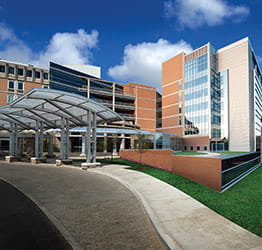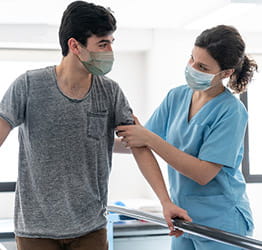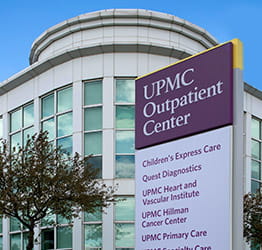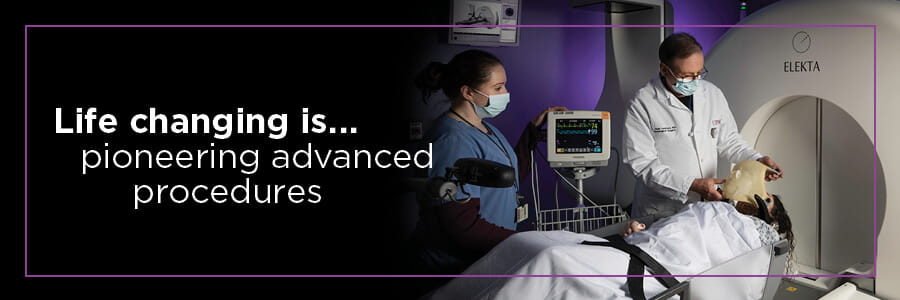What Is Gamma Knife Radiosurgery?
Gamma Knife radiosurgery is a noninvasive, highly precise radiation treatment for brain tumors and other brain conditions. It is a type of stereotactic radiosurgery (SRS) that uses targeted radiation beams to treat brain conditions.
Gamma Knife treatment is not surgery; there are no actual knives or long incisions involved. Instead, Gamma Knife is a radiation treatment. Highly focused gamma rays target the affected part of the brain while minimizing exposure to surrounding healthy tissue.
The goal of Gamma Knife is to inactivate brain tumors and other brain conditions. Because it does not typically require incisions or general anesthesia, it may be a safer alternative to open surgery. It can also target deep brain tumors, arteriovenous malformations (AVMs), and other conditions that may not otherwise be operable.
Gamma Knife is a precise, effective, and safe treatment. It targets a specific area of your brain and prevents damage to surrounding tissue. The amount of radiation can be customized for your condition. The goal of treatment is to destroy AVMs and stop tumor growth, which also sometimes shrinks tumors.
At an advanced center like UPMC, Gamma Knife is a common procedure for complicated brain tumors and conditions. UPMC performs about 600 Gamma Knife procedures each year and achieves excellent outcomes.
Conditions we treat with Gamma Knife radiosurgery
Why Would I Need Gamma Knife Radiosurgery?
As a treatment, Gamma Knife radiosurgery can address brain tumors and other disabling, debilitating, or life-threatening brain conditions. It may cure certain conditions, lengthen your lifespan, and/or improve your quality of life.

Gamma Knife can provide a treatment option for tumors and conditions deep in the brain that may not otherwise be operable. It also can complement other surgical procedures by helping to treat any remaining tumor or lesion.
Gamma Knife is an extremely precise procedure with sub-millimeter accuracy. It is also noninvasive, meaning patients experience fewer complications and a shorter recovery time. The majority of patients are treated and are discharged home the same day.
Who is a candidate for Gamma Knife radiosurgery?
Many factors play a role in determining whether you are a candidate for Gamma Knife treatment, including:
- Your age and overall health.
- Your symptoms.
- The size, location, and complexity of your tumor or other condition.
UPMC experts will evaluate your case using a multidisciplinary team approach. Our team includes experts in neurosurgery, radiation oncology, medical oncology, neuro-oncology, nursing, and other specialties. We discuss your case as a group to determine if you are a candidate for Gamma Knife or another treatment option.
What Are the Risks and Complications of Gamma Knife Radiosurgery?
You may experience some short-term side effects after Gamma Knife treatment, including:
- Fatigue.
- Headache.
- Nausea.
- Scalp irritation or soreness at the pin sites.
- Swelling in the treated area.
- Temporary hair loss.
Long-term complications of the procedure are rare but can include:
- Brain swelling.
- Infection.
- Seizures.
- Vision or hearing loss.
Talk to your doctor if you are concerned about complications of the procedure. These complications are rare and typically can be treated with medication if they occur.
What Should I Expect from Gamma Knife Treatment?
Before: How to prepare for your Gamma Knife procedure
You may need to stop eating and drinking by midnight the night before your Gamma Knife treatment. The nursing staff will give you specific instructions for your procedure.
Ask your doctor about any prescription drugs you take. They will tell you which medicines you can and cannot take on the day of your procedure.
The day of your treatment:
- Arrive at the time your care team instructs you to.
- Bring a loved one who can drive you home.
- Dress in comfortable clothes.
- Do not wear jewelry, hair pieces, makeup, or nail polish.
- Do not use hair products like spray or gel. Your doctor may give you a special shampoo to wash your hair.
- Remove contacts, glasses, and dentures before the procedure.
Before the treatment begins, your care team will obtain high-definition MRIs of your brain. The imaging will show the exact location, size, and shape of the tumor or other problem area, helping to ensure accuracy during the procedure. Additional testing may be needed on the day of the procedure, depending on your diagnosis.
How long does Gamma Knife radiosurgery take?
The Gamma Knife procedure typically takes less than an hour. For more complex cases, it may last longer than an hour. Most patients go home on the same day of their procedure.
During your Gamma Knife procedure
You will have an IV placed and can have medicine to help you relax if you need it. However, you will not typically receive general anesthesia — you will be awake throughout the procedure. The treatment itself is painless.
There are two options for Gamma Knife treatment: a frame-based procedure and a mask-based (frameless) procedure.
For the frame-based procedure, your team will fit you with a circular metal frame that holds your head in the right place. They will then attach the frame to your scalp and skull with small pins that puncture the skin. You will receive local anesthesia and moderate sedation by IV.
For the frameless procedure, your team will fit a specialized mask over your face. The mask is contoured to your face and helps you keep your head and face still during treatment. You will not typically need sedation or local anesthesia.
Both the frame and mask are specially designed to hold your head in place as the Gamma Knife system delivers precise radiation treatment.
During the procedure:
- You will lie on a table, and your team will secure your head to the table.
- The table slides into a machine that delivers the radiation. After your head is properly positioned inside the machine, the table will stop moving, and the treatment will begin.
- Your care team will go to another room. They will monitor you using cameras, intercom, and call bell.
- The Gamma Knife unit will deliver the radiation. You will not feel anything while the radiation is delivered.
- The radiation targets the diseased tissue while leaving healthy tissue intact. Almost 200 beams of radiation target the specific treatment area.
The treatment typically lasts less than an hour.
Recovery after Gamma Knife radiosurgery
How long will I be in the hospital?
After treatment, your care team will remove the frame or mask that kept your head in place during the procedure. If you had the frame procedure, your team will bandage the areas where the pins were placed.
You will move to a recovery area where your care team will monitor you to ensure you recover well. You can eat or drink as soon as you are able. You may have a headache after the frame removal. If so, your care team will give you medicine to make you feel better.
You should be able to go home on the same day as your procedure. You will need someone to drive you home if receiving sedating medication.
What will you send home with me?
You will receive instructions on how to care for yourself at home in the days after the procedure. If you had the frame procedure, we will give you instructions on caring for the sites where the pins were placed during the procedure.
How long does it take to recover?
Many patients can return to their normal daily routines the day after their Gamma Knife procedure. That includes work and other activities.
You may feel some side effects, such as fatigue, for several days after the procedure. Fatigue and other side effects are generally mild and go away soon.
You should experience a lessening of the symptoms related to your condition over time.
How often will I need to come back for treatment?
You will need follow-up imaging. Depending on your health issue, you may need just one Gamma Knife treatment or more sessions. Your doctor will provide more details.
When to call your doctor about post-op symptoms
Complications are rare after Gamma Knife treatment. However, you should call your doctor if you experience seizures or other unexplained symptoms.
What is the prognosis after Gamma Knife radiosurgery?
Your life expectancy and overall prognosis after Gamma Knife radiosurgery depends on your health problem.
Potential results of Gamma Knife treatment for various conditions include:
- Acoustic neuroma — Treatment can limit the growth or reduce the tumor size with little risk of lasting nerve damage.
- Arteriovenous malformation (AVM) — Blood vessels in the AVM can thicken and close.
- Brain tumors — Treatment damages the genetic material in the tumor's cells so that they are no longer able to reproduce. The cells inactivate, and the tumor may gradually shrink.
- Pituitary and skull base tumors — Treatment can shrink the tumor and lessen the disruption of the pituitary hormones.
- Trigeminal neuralgia — Treatment alters the nerve fibers that cause intense face pain.
Your doctor can give you more details about what to expect after the procedure.
What is the success rate of Gamma Knife radiosurgery?
Since 1987, UPMC has successfully performed more than 19,000 Gamma Knife treatments for patients with:
- Benign or malignant brain tumors.
- Pain and movement disorders.
- Vascular malformations.
- Other functional problems.
At UPMC, we have performed Gamma Knife radiosurgery on more than 1,500 patients with arteriovenous malformations. The treatment has destroyed 70% to 90% of AVMs within three years — delivering better outcomes than other treatment options.
We have also performed more than 1,600 Gamma Knife procedures on patients with acoustic neuroma — a tumor on the nerve connecting the inner ear to the brain that can cause deafness. The treatment prevented tumor growth in 97% of patients, and up to 80% kept their hearing in the long term.
UPMC has seen similar excellent outcomes for the other conditions treated with Gamma Knife.
Why Choose UPMC for Gamma Knife Radiosurgery?
UPMC installed the first North American Gamma Knife in 1987. Since then, we have introduced and pioneered multiple technological improvements.
Today, UPMC is a national and international leader in Gamma Knife treatment. We perform about 600 procedures each year with excellent outcomes. We are also a major teaching center for neurosurgeons, radiation oncologists, health physicists, and nurses from around the world.
We use a multidisciplinary team approach to treat each patient. Our team of neurosurgeons, medical oncologists, radiation oncologists, and neuro-oncologists meets frequently to discuss patients. Together, we manage each patient from diagnosis through treatment.
UPMC has two Gamma Knife units: the Gamma Knife Esprit and the Gamma Knife Icon. We are one of only a few hospitals worldwide with two Gamma Knife units.
The GK Esprit is the most state-of-the-art Gamma Knife unit available today. It uses artificial intelligence, advanced robotics, and other technological advancements.
Together, the advanced technology provided with the Icon and Esprit:
- Allows for a frame-based or frameless approach to radiosurgery, giving surgeons more options when treating complex brain issues.
- Offers dosage control and motion management systems to administer treatment with extreme accuracy.
- Uses radiological images to target areas in the brain more precisely than ever before.
Since installing the first Gamma Knife at UPMC, we have performed more than 19,000 procedures. We have achieved excellent outcomes in tumor control, AVM obliteration, and more, with outstanding patient satisfaction.
By UPMC Editorial Staff. Last reviewed on 2025-03-19 by Costas G. Hadjipanayis, MD, PhD.




















